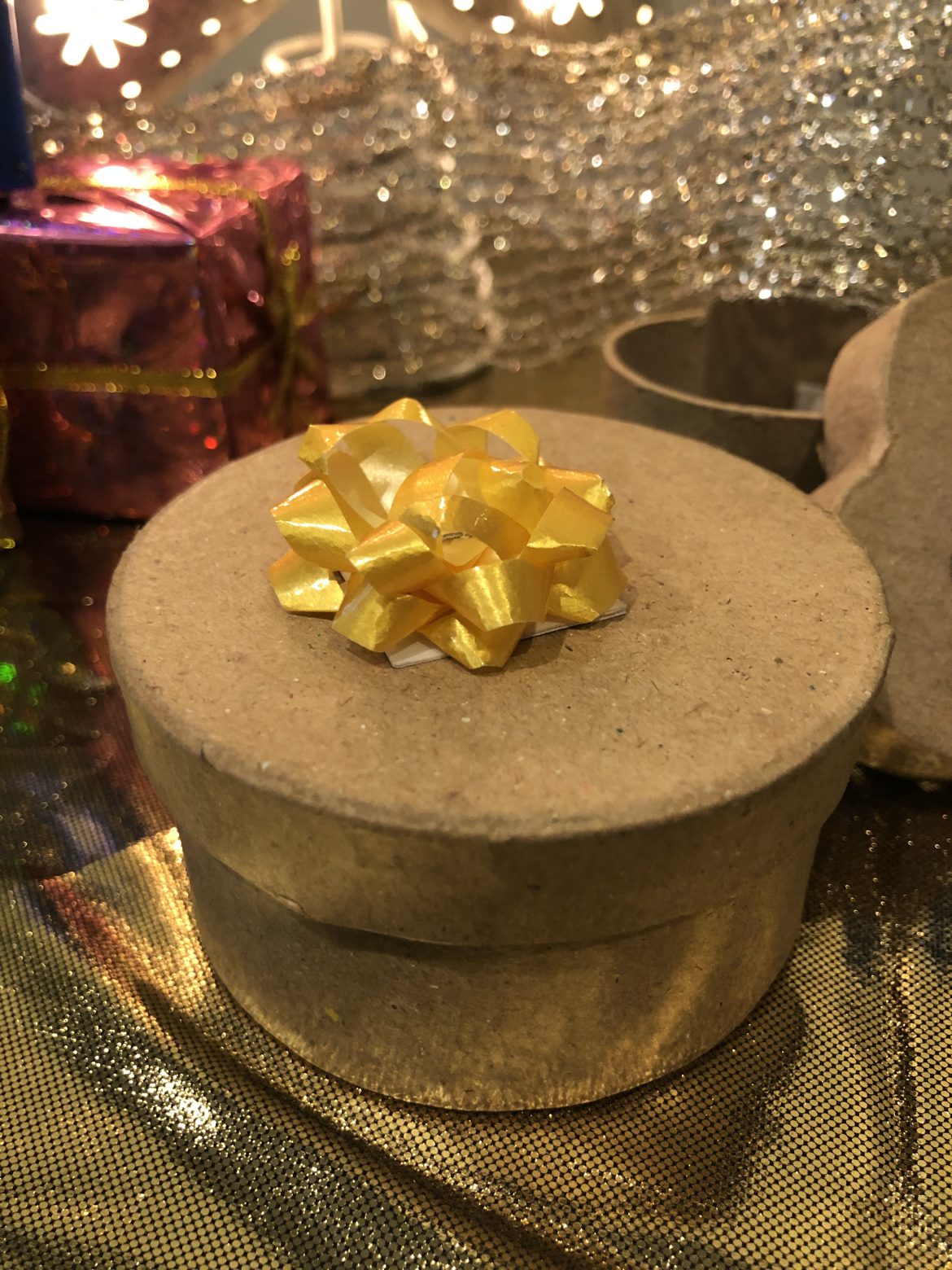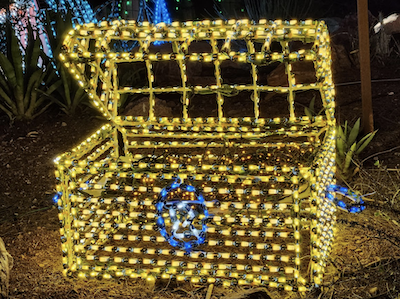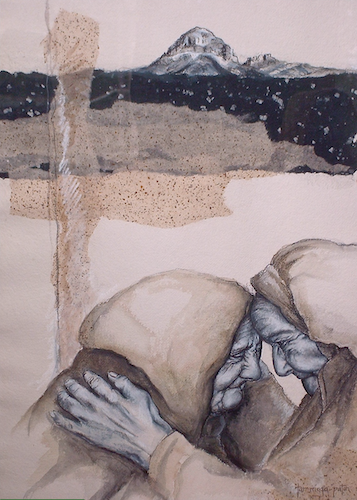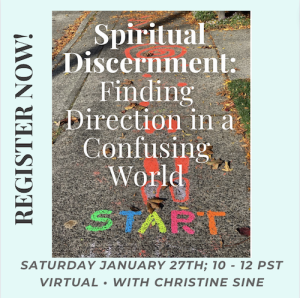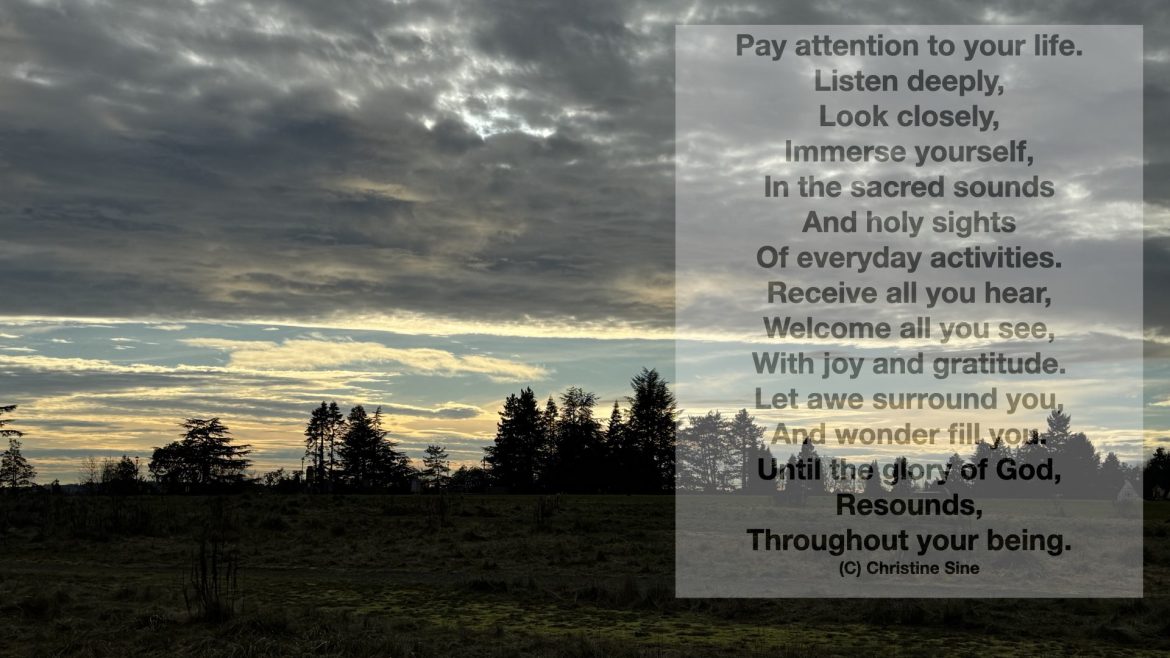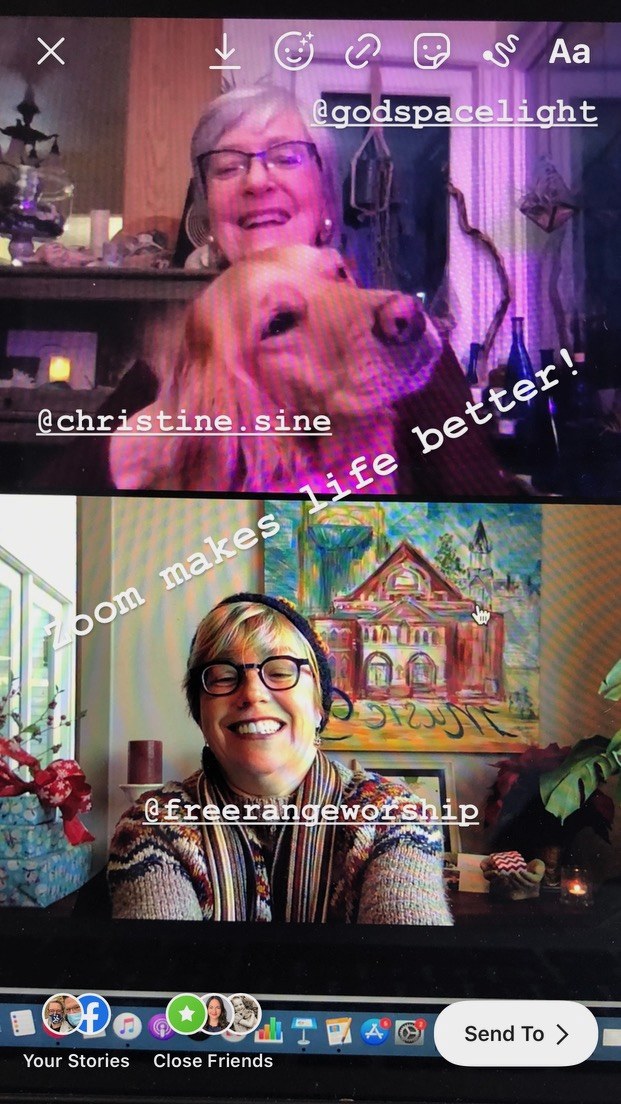As I said last week, Christine Sine and I share a birthday week! Both of us are January babies. As a kid, I didn’t like having a birthday in January because I usually had exams on my birthday and often my parents and others had given so much at Christmas that January was light on gifts.
This year I’ve had a lot of fun celebrating my birthday with last minute trip our to visit my sister in the Pacific Northwest. I greatly apologize to all of my friends who I didn’t get to see. I had planned to host a coffee with Seattle friends but due to the snow and ice in Nashville, I didn’t get to leave when I’d planned and almost didn’t make the trip at all! I actually ended up taking my suitcases down our hill on a sled to meet my Lyft driver. (that’s a great story for another post! ) It was a working trip so I didn’t have a lot of time to play. But it was a great GIFT to get to see the mountains and the snow up in Lynden where my sister lives. My work was helping her decorate after a long remodel project! Got to use my atmosphere architecture gift in a different way!

Since I was blessed with birthday gifts this week, here are a few I want to give to myself and to you and our world this year!
The Gift of Beauty…taking time to notice and discover the beauty around us. Take time to notice the clouds, the colors, the smiles on people’s faces.
The Gift of Silence…taking time to listen …to God, and for God. Turning off the noise of life and really being still. Creating a space daily for silence and making a way for a longer retreat time of silence.
The Gift of Listening… to each other! Truly taking the time to notice and know the people in our world. AND taking time to listen to ourselves. What are we needing? What is our heart longing for?
The Gift of CURIOSITY…learn something new every day! Be like Ted Lasso…Be curious and not judgmental. What do you want to learn more about? What is something you’ve dreamed of learning but haven’t gotten around to YET?
The Gift of OUTSIDE….taking time each day to get outside and breathe fresh air. When you are spinning inside or anxious, take a walk! Invite a friend to join you!
The Gift of ALL our SENSES…goes along with beauty and curiosity and getting outside! We have lost a lot of our senses due to staring at screens all day long! Touch taste smell hear, see! EXPERIENCE life! What is your favorite thing to smell? What are tastes that bring you joy? Notice textures and colors too! Color with crayons!
The Gift of PLAY…What brought you JOY as a kid? How can you do more of that? Sledding last week was so joy filled for me!
The Gift of FRIENDS and Community. We’ve all gotten out of the habit of being together. We all get really busy and don’t take time to call or plan a coffee date. Let’s change that this year and make some new friends too!

The Gift of REST! You know that’s my favorite! Did you know there are seven kinds?
The GIFT OF KINDNESS to ourselves as well as to one another! What if we talked to ourselves in a kind and nurturing way each day rather than beating ourselves up when we lose our keys or forget an appointment or a birthday? Notice what your self talk is like and give yourself the gift of kindness!
The GIFT OF HOPE
I feel like I am just getting started on this new year, even though it’s already the last week of January!
I seem to have lots more questions than I have answers and my calendar has a lot more empty space than it usually does. Some of that is good and some of that feels really scary. I need more paid work but what is mine to do this year?
If I’m being honest, the fact that it’s an election year here in America is very unnerving….and fills me with dread. And then there are all the wars and suffering….it’s A LOT!!! I feel we all NEED THE GIFT OF HOPE!
READ THE PSALM and let Jesus speak to you…
Truly my soul finds rest in God; my salvation comes from him.
2 Truly he is my rock and my salvation;
he is my fortress, I will never be shaken.3 How long will you assault me?
Would all of you throw me down— this leaning wall, this tottering fence?4 Surely they intend to topple me from my lofty place;
they take delight in lies.With their mouths they bless,
but in their hearts they curse.5 Yes, my soul, find rest in God; my hope comes from him.
6 Truly he is my rock and my salvation; he is my fortress, I will not be shaken.
7 My salvation and my honor depend on God[c]; he is my mighty rock, my refuge.
8 Trust in him at all times, you people; pour out your hearts to him,
for God is our refuge.9 Surely the lowborn are but a breath, the highborn are but a lie.
If weighed on a balance, they are nothing; together they are only a breath.
10 Do not trust in extortion
or put vain hope in stolen goods;though your riches increase,
do not set your heart on them.One thing God has spoken, two things I have heard: “Power belongs to you, God and with you,
Lord, is unfailing love”; and, “You reward everyone according to what they have done.”
PSALM 62:1 NIV
This Psalm gives me hope!
How are you doing as this year begins? Are you feeling hopeful or anxious?
What gifts do you need to receive?
What GIFTS do you want to OPEN in this new year? Pick a couple to open this week!
As my friend Scott Erickson reminds me ….we don’t have to…WE GET TO! Life is a Gift we get to open each day!
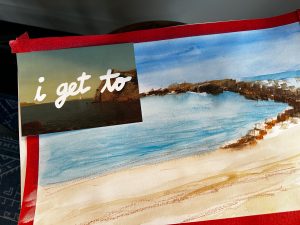
Thank you Jesus for the Gift of a new year! Thank you for birthdays and friendships and hot tea on a cold day! For snow fall and sledding and laughter, and tears too. You are in the celebrations with us and in the sadness. Help us all to remember that you hold us in the palm of your hand and love us more than we can understand or even imagine! Thank you that we GET TO open our hearts and our lives to you each day.
We love you Jesus! AMEN
©lillylewin and freerangeworship.com
.
by June Friesen
We are into another year. A year of treasures yet to be embraced and lived. So many questions tend to want to take up residence in our thoughts as to where, what, why, how etc. When I take time to consider the Scriptures and the many stories recorded for our instruction and examples movement tends to be a given. We have all opened new calendars with the year 2024 in bold numbers. And with the opening of the new calendar we also begin to realize that there are so many adventures ahead and for many of us there will also be many unexpected adventures and beginnings as well. I for one find myself upon a new precipice – moving once again. I find myself more intrigued as it comes closer as we are moving into a home we had already lived in for many years. So what is God up to now? What does He have in mind for this season that in many ways seems to be once again holding new beginnings?
I find myself pondering many moving situations in the Scriptures and no doubt in some cases people reacted a bit like I am feeling. Abraham was one who no doubt wondered many times what is God going to think of next? What is going to happen next? Where am I ever going to get to put down roots? And besides that I am sure he wondered abut the promise of all the descendants God promised him as he grew old and still had no children. I have chosen a few verses from Genesis 13 to share today.
God said to Abram, “Open your eyes, look around. Look north, south, east, and west. Everything you see, the whole land spread out before you, I will give to you and your children forever. I’ll make your descendants like dust—counting your descendants will be as impossible as counting the dust of the Earth. So—on your feet, get moving! Walk through the country, its length and breadth; I’m giving it all to you.”
It had taken Abraham some traveling and moving around before he really was able to settle down in the land of Canaan that God had promised him. I am sure that he was wondering when was he going to get to settle down and no doubt his wife Sarah was wondering as well. I also have to wonder how many times she must have complained – ‘not again.’ Abraham somehow found himself taking what I call the long way around to the promised land. What made Abraham obedient to each of these moves? It is true that at least one or two of the moves were because of famine in the area he was living at a certain time. None the less the important thing is obedience to go and to do what God says and when God calls. And in the end he was able to finally settle in the ‘Promised Land’ – the land that is often described as the ‘land of milk and honey’ which I choose to define as a land of promised blessing and care by God.
Forty-four years ago I found myself packing up our household. It was an interesting time as I packed most of it to remain behind including all our furniture. We (my husband, our two small sons and myself) shipped a few boxes and packed or maybe stuffed our car and started on a journey of some 2800 miles give or take a few as we stopped to see some family on the way. My husband had one year of schooling to complete a degree. Then instead of moving back to where our things were, we found ourselves having to return just to retrieve our things from Toronto as we moved to Phoenix, Arizona where we still live today. As I pondered the verses from Genesis today, I too have to think what a trip life has been just living within a radius of about twelve miles and this makes the fifth move in forty three years. Each move finds us making changes as I am sure Abraham found as well. So what will one pack, what will one discard, and what will one leave behind? I actually have learned a few things and again I am learning.
 God’s Promises Are Always Good – New and Fresh Every Morning
God’s Promises Are Always Good – New and Fresh Every Morning
God, what is ahead I ask?
What is Your plan for me?
What do I need to take with me this time?
Will this not be the last trek I need to prepare for here on this earth?
As I consider Abrahams’s journey with You
He faithfully followed Your call to move
Even though at times it was not a long distance,
And all the time he no doubt was wondering –
‘Where is this special land God has for me?
And when will God give me an heir(s)
To multiply and bring about a people –
With a population greater than the amount of stars in the sky?
God, sometimes we also feel a bit like Abraham –
We wonder where we will ever get to settle in
And really put roots down –
As just when we feel our nest is securely made
The call is to open the wings
And begin to fly again.
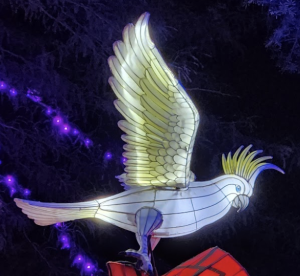 Does the bird too feel this way as he/she sets out on a journey
Does the bird too feel this way as he/she sets out on a journey
Flying from a resting place to a nesting place?
Does the bird sometimes feel too
That like is rather difficult as just when I have settled it is time to be on the fly again?
As one considers the bird,
As one considers Abraham and Sarah,
As one considers the peoples of the earth,
Many are the reasons to move onward –
It may be that new opportunities of education or work await –
It may be that one has become too settled or complacent about life
Possibly losing focus on God and actually having become rather self-centered.
And so it is that God says –
Arise, come and see this new place I have for you,
Come and see the beginnings I have for you,
Come and see what only I your God can do,
And not only will you be surprised
But you will be wowed as well.
So spread your wings my dear child,
Let Me become the wind under your wings,
You and I are going to rise and soar once again
And no, you will not get tired as I am Your energy,
You will not grow weak because I am your strength,
You will not fail in what I have because I have got your back,
Yes, my dear child,
You are on a growing spurt once again –
And just you wait as you start to see
What it is that I have in my plan for you and Me.
Remember when you study about My ways in the Scriptures,
I often chose to use those who thought they had completed their life call,
And it was just about that time that I showed up again
And said ‘oh but I have another plan yet’
And off we would go again.
And so it is with you my friend,
I still have more that only you can do
As I have it in a cache marked with your name –
And it was/is time to open a new beginning once again.
Remember in the Scriptures age meant nothing to me –
I chose young, I chose elderly,
I chose men, I chose women,
I chose children and
A couple of times I even used some of my creatures.
So, my dear child,
Embrace today, and be ready to embrace tomorrow,
Embrace the week that is coming as well as the month ahead
And let us see not only what this next year holds
But onward let us go and see what it is that your life indeed yet holds.
And so I choose to place my hand in His,
And I begin this new journey, this new move in my life,
And as I do I ask:
“Will you too choose to embrace the new beginnings God has for you?”
Your will be glad you made that choice in the end –
So –
SPREAD YOUR WINGS AND RISE WITH THE SPIRIT’S ENERGY
INTO GOD’S NEW BEGINNINGS FOF YOU!
AMEN AND AMEN!
photos by June Friesen. Scripture take from The Message
“Shelter” by Karen Tamminga-Paton
by Karen Wilk
As I consider this month’s theme of discernment, I wonder if learning to discern is very much a part of the call of God’s people to be ‘elders’ in our communities. We first come across the word “ecclesia” which we usually translate ‘church’ in Scripture when Jesus says, ‘upon this rock I will build my ‘ecclesia.’ The “ecclesia” originally denoted, “a gathering of wise community leaders, brought together by their common vision for the ‘Shalom’ of the wider community. In essence, the ecclesia was a community within a community whose function was to add value to the place in which they lived. (Michael Frost & Alan Hirsch, ReJesus, 32)
Paul tells Titus (1:5) and us, “To appoint elders in every town.”
But where are these elders for us to appoint? And what does it look like to not just get older but to get elder?
Could the church really be the wise attentive, Shalom seeking and embodying leaders/elders among, with and for their neighbourhoods? I wonder and I invite you to ponder with me:
Elder versus Older
We’re all getting older
There’s no changing that
We can try to cover-up, make-up
…..Hide where we’re at
Yet
…..That
…..…..Each day, month, year passes
…..…..…..…..…..…..…..…..…..…..is a fact.
The question is
Are we getting elder?
Wiser, more present and aware
Not just of ourselves but of others to care
Responsible, risking sharing
…..Willing to listen, our opinions sparing
…..…..in integrity and humility growing
…..…..…..In our postures, respect and kindness showing
Ready for welcoming, each and all accepting
God at work, Creator’s image-bearing.
Not all that get old, get elder.
Some get selfish, grumpy, bitter.
Are we wrinkled just with time
…..Or with the sage’s mindful lines?
Are we aching just with stiffness pain
…..Or with heartache for havoc holding the rein?
Though tired from interrupted restless sleep
…..Do our eyes with the suffering and grieving weep?
Can we,
…..will we,
…..…..pay attention, stay awake
…..Will we speak up, question, do what it takes?
Will we not just get older but be an elder
…..living love and grace, a helper, a shelter.
It’s time to sign up for our upcoming retreat Spiritual Discernment: Finding Direction in a Confusing World. Christine Sine will facilitate an exploration of practices that enable us to become “all ears” and listen in all circumstances to the voice of God. This session will be full of helpful input, discussion and creativity. Come join us and learn to listen more deeply to the voice of God.
Sign up for all three upcoming retreats at a considerable discount.
It looks as though I got it wrong. Last week, at least the early part of it, did not turn out to be my birthday week at all. As I mentioned in my Meditation Monday: Pay Attention, Find Joy, Be Discerning, all the plans I had for the week seemed to dissolve in accidents, illness and unexpected happenings. I couldn’t believe how much I use my left hand and how much a simple cut could slow me down. However it has only delayed things not cancelled them .
Fortunately, my focus on paying attention to my life enabled me to relax and go with the flow of what was happening rather than get frustrated by what I missed out on. The poems I share in my Meditation Monday: Pay Attention, Find Joy, Be Discerning are a sample of what I learned this week because I slowed down and took notice. As well as that, I started reading Slow Seasons by Rosie Steer. Talk about fortuitous. Drawing on experiences growing up in Scotland, she guides us through the old Celtic calendar and encourages us to slow down and tune into nature’s rhythms to get back what is is important. She comments “Maybe it’s because the world is so complex and busy that we cling to goals and achievements to carve out a sense of control, to shape our own narratives…. Foraging a new path in the forest of life takes time and effort. You need to muster your commitment to new patterns of thinking, exposing yourself to new experiences – and yes, sometimes the attendant anxieties they bring – to create a healthier path that, over time will become well-trodden. (Slow Seasons by Rosie Steer, 11)
Discernment as a way of life means that we don’t necessarily try to set goals or make resolutions, but learn to listen to the world and people around us. It is a fun and satisfying process that enriches our lives and relationship to God. I hope you will join us on Saturday for our retreat Spiritual Discernment: Finding Direction in a Confusing World when we will explore this in more detail. We would love it if you would consider joining us for all three winter/spring retreats.These will nourish your life and help to guide you through the year ahead.
Imbolc, is the next event on the Celtic Calendar and the related Candlemas on the Church calendar. These are fun occasions to celebrate. You might like to make a St Brigid’s cross like I did last year. Or bless your candles as Carol Dixon invites to in this lovely Candlemas celebration. Ash Wednesday and Lent are not far behind, this year beginning on Valentine’s Day. This reminds me that the last time this happened I used the theme “For Love of the World God Did Foolish Things” for Lent. It was both fun and revealing and I am considering using this for my focus this year too. You can check out all our Ash Wednesday and Lent resources in our resource centre.
As you know I am a strong believer in the need for ritual in our lives, to mark the passing of the seasons and to celebrate both the joy and the sorrow of life. We can’t have mountain top experiences without valleys where the visions and revelations we received are lived out. Celebrating both the highs and the lows encourages us to develop a healthy rhythm of life.
This week on the Godspacelight blog June Friesen in her post, Opportunity for New Beginnings ponders the resurrection and its promise of new beginnings. A great reflection as we start to get ready for Lent and Easter. In her Freerange Friday: Happy Birthday Christine Lilly Lewin offered us a Birthday Examen, a wonderful way look back and forward, see who we have been and who we are becoming. Even if it is not your birthday, this is a great examen to use. Ana Lisa De Jong offered us another series of poems this week too. Her poetry is very inspiring and I heartily recommend it.
My favourite post this week was Elaine Breckenridge’s Wassail, Wassail in which she describes the wassailing tradition in which apple orchard trees are blessed. It is an ancient tradition, well worth reviving for today. Here in the Pacific NW, where we have lots of apple trees, it is particularly meaningful.
The Liturgical Rebels podcast is on its way, but as so often happens with new projects, it is a little delayed. I had a fun interview with poet Drew Jackson this week and have another scheduled on Thursday with artist Scott Erickson. As I start this podcast, I am reminded that as the Hebrews paraded around Jericho, it was the musicians that led the way, the artists, the creatives are the ones whom I think always lead the way for us into new ways of thinking and new perspectives on the gospel story, so that is why we are starting with artists, poets and hopefully musicians. Your prayers are appreciated as we prepare to launch. There have been a few unexpected bumps in the road but I am excited about where this is going, so excited in fact that it has disturbed my sleep this week.
As I contemplated this new beginning this poem sprung to life:
A new adventure is unfurling,
Weird and wonderful,
Worthy of savouring,
Its unknown depths
And unexpected turns.
With new horizons to explore,
And stunning vistas to admire,
There is quiet potential
In its whispered promises,
Any hidden opportunities.
I celebrate its coming.
I relish the blessings and the privilege,
The wonder of its emerging,
Touches me with awe.
Many blessings and thank you for your prayers.
Christine Sine
THIS SATURDAY:
Join Christine Sine January 27th, 2023 10 am – 12 pm PT for a virtual retreat, Spiritual Discernment: Finding Direction in a Confusing World, as she facilitates an exploration of practices that enable us to become “all ears” and listen in all circumstances to the voice of God. This session will be full of helpful input, discussion and creativity. Come join us and learn to listen more deeply to the voice of God.
What does it mean to pay attention to your life? I am contemplating that question as I sit in my quiet place listening to the birds sing and watching the mountains glow in the early morning light. Paying attention is about taking notice of ourselves, God, our neighbours, the earth on which we live and the circumstances in which we find ourselves.
Many of you know that last week was quite an unexpected and challenging one and so all the plans I had for the week seemed to dissolve in accidents, illness and unexpected happenings. Part of what it taught me is the importance of going with the flow and not allowing myself to be overwhelmed by the unexpected and uncomfortable. I realize more and more that frustration at a challenging day is usually because I want to control what happens and don’t like it when my plans go haywire. As Nouwen reminds us, “The gift of discernment is the ability to hear and see from God’s perspective and to offer that wisdom from above to others.
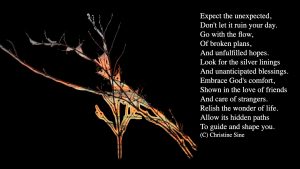
Pay Attention to your body
Getting older makes us more aware of our bodies, our aches and pains, the signals that tell us to slow down. We need to take notice of how this impacts what we can expect of ourselves each day, not resenting these changes but welcoming the new revelations of God that they bring. What are the signals that say you are going too fast or too slow? What are the promptings that make you aware you are not getting enough exercise or eating the right food and neglecting your health? Hurting my hand encouraged me to reflect on these kinds of questions again. It was a gentle reminder of my need to listen more closely to my body.
I keep a record of my daily steps and exercise. I also count my calories. I realize with horror that I am far more sedentary than I thought. Sitting for long periods is not good for me – for my heart, my muscles or my bones – and I need to intentionally change my behaviour.
Pay Attention to your Soul
I try to pay attention to my soul and the emotions that simmer beneath the surface, but it isn’t always easy, in the busy priority of work and hospitality. There are currents of joy, pain, tension, quiet longings and frantic desires. They all need to be paid attention to. How self aware am I? What gives me joy? What depresses me? What breaks my heart? What are the implications for my life, my relationship to others and to God? Even more importantly what do I do about it?
Tend Your Spirit
How do we tend our spirits? This week my personal space is very messy, and I know that often reflects the state of my spirit. Mess means a chaotic spirit, easily distracted by bits and pieces of work projects I spread around me. Computer open first thing in the morning means social media has taken priority over God.
How close do I feel to God today? What have I done to nourish that closeness? How have I pushed God away. Creating a space for Godtime requires a deliberate act of placing my computer under my desk and stacking my work into a neat pile that does not distract me.
Take Notice of God’s World
Celtic Christians believed that creation was translucent and the glory of God shone through. A raindrop, a ripe strawberry, even a broken branch reflect something of who God is. My love of creation grows every year, and the beauty and the wonder of God’s world fills me with awe. Unfortunately, especially in the winter it is easy to let go of this focus. I still need to take time to look and listen and touch, to allow the glory of God reflected in creation to seep into my being. (I will talk more about this next week).
Pay Attention to the People In Your Path.
All people are God’s people, made in God’s image to reflect who God is. Even the most broken people (and we are all broken people) can draw us closer to the God we love. Yet we easily listen to some and dismiss others. We pay attention to those we like or whose opinions we agree with and ignore or demonize others who think, look or worship differently. We sit in fellowship with those who make us comfortable and distance ourselves from those who make us uncomfortable.
Who do you listen to? Who helps you relax? Who do you ignore? Who will God speak through in unexpected and surprising ways?
These are questions I grapple with more and more. The more intentionally I take time and create space for these questions to pay attention, the more grateful I become for all the ordinary, mundane aspects of life, and the ordinary people who impact my life. Drawing again from Noun’s wisdom:
Together, God’s people ground me in the reality and wholeness of Christ and his church, holding me firm and safe in God’s living embrace. God speaks regularly to us through people who talk to us about the things of God. Certain people become living signs that point us to God. Whether in life of in memory, the people God puts in our lives can help guide us and show us the way. (Henri Nouwen, Discernment: Reading the Signs of Daily Life, 81)
What is Your Response?
Watch the video below. What encourages you to pay attention to God’s world, to your inner self and to God’s people around you? What makes you dance to the music of God’s world and the song of God’s voice?
Join Christine Sine January 27th, 2023 10 am – 12 pm PT for a virtual retreat, Spiritual Discernment: Finding Direction in a Confusing World, as she facilitates an exploration of practices that enable us to become “all ears” and listen in all circumstances to the voice of God. This session will be full of helpful input, discussion and creativity. Come join us and learn to listen more deeply to the voice of God.
by June Friesen
As we have anticipated the celebration of Christ’s resurrection I have continually been reminded of the opportunity this gives us in the Christian faith to ponder new life, a life that is different than it was before. Indeed Christ’s life was different after the resurrection as now he no longer had the humanity issue of sin holding onto His power. He had conquered the ‘death power’ of sin over His human form as well as opened an opportunity for humanity to now embrace a spiritual life in a new way. When one takes advantage of this opportunity that Jesus offers it holds untold gifts, the greatest being the promise of eternal life in heaven. However, in this world discouragements arise and at times they can become overwhelming. Let me share a couple of Scriptures.
1 John 2:24-25
24-25 Stay with what you heard from the beginning, the original message. Let it sink into your life. If what you heard from the beginning lives deeply in you, you will live deeply in both Son and Father. This is exactly what Christ promised: eternal life, real life!
Philippians 2:5-16
5-8 Think of yourselves the way Christ Jesus thought of himself. He had equal status with God but didn’t think so much of himself that he had to cling to the advantages of that status no matter what. Not at all. When the time came, he set aside the privileges of deity and took on the status of a slave, became human! Having become human, he stayed human. It was an incredibly humbling process. He didn’t claim special privileges. Instead, he lived a selfless, obedient life and then died a selfless, obedient death—and the worst kind of death at that—a crucifixion. 9-11 Because of that obedience, God lifted him high and honored him far beyond anyone or anything, ever, so that all created beings in heaven and on earth—even those long ago dead and buried—will bow in worship before this Jesus Christ, and call out in praise that he is the Master of all, to the glorious honor of God the Father. 12-13 What I’m getting at, friends, is that you should simply keep on doing what you’ve done from the beginning. When I was living among you, you lived in responsive obedience. Now that I’m separated from you, keep it up. Better yet, redouble your efforts. Be energetic in your life of salvation, reverent and sensitive before God. That energy is God’s energy, an energy deep within you, God himself willing and working at what will give him the most pleasure. 14-16 Do everything readily and cheerfully—no bickering, no second-guessing allowed! Go out into the world uncorrupted, a breath of fresh air in this squalid and polluted society. Provide people with a glimpse of good living and of the living God. Carry the light-giving Message into the night so I’ll have good cause to be proud of you on the day that Christ returns. You’ll be living proof that I didn’t go to all this work for nothing.
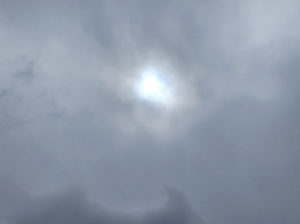 I have chosen to place this photo next as it really was a scene in the sky that brought the title of this writing to my spirit. Recently I was out for a walk with my dog Sasha. It was a blustery, cloudy day with a few sprinkles of rain intermittently. I often glance upwards, not too long, as that can be disastrous if there is an unexpected obstacle in my way. I noticed that the sun was really present although hidden. The wind was blowing and the clouds were on the move – and I noticed that depending on the thickness of the clouds the sun was more visible at times than others. Immediately my mind said, “Well, that is a great example of the Son. He is up in the heavens too, too far for the human eye to see. At times He is more present in my life than He is in others – but He is always there.” Hebrews 13: 5-6 says, “ Don’t be obsessed with getting more material things. Be relaxed with what you have. Since God assured us, “I’ll never let you down, never walk off and leave you,” we can boldly quote, God is there, ready to help; I’m fearless no matter what. Who or what can get to me?” As I pondered the presence of God 24/7 and how at times I am so aware and at other times I forget that He is present – again I learned a new way to embrace God each and every day and in each and every situation/circumstance.
I have chosen to place this photo next as it really was a scene in the sky that brought the title of this writing to my spirit. Recently I was out for a walk with my dog Sasha. It was a blustery, cloudy day with a few sprinkles of rain intermittently. I often glance upwards, not too long, as that can be disastrous if there is an unexpected obstacle in my way. I noticed that the sun was really present although hidden. The wind was blowing and the clouds were on the move – and I noticed that depending on the thickness of the clouds the sun was more visible at times than others. Immediately my mind said, “Well, that is a great example of the Son. He is up in the heavens too, too far for the human eye to see. At times He is more present in my life than He is in others – but He is always there.” Hebrews 13: 5-6 says, “ Don’t be obsessed with getting more material things. Be relaxed with what you have. Since God assured us, “I’ll never let you down, never walk off and leave you,” we can boldly quote, God is there, ready to help; I’m fearless no matter what. Who or what can get to me?” As I pondered the presence of God 24/7 and how at times I am so aware and at other times I forget that He is present – again I learned a new way to embrace God each and every day and in each and every situation/circumstance.
JESUS – BRINGS OPPORTUNITY FOR NEW BEGINNINGS!
New opportunities!
New beginnings!
Sometimes they come daily.
Sometimes they come hourly.
Sometimes they come weekly.
Sometimes they come yearly.
Sometimes they are marked by segments of years, accomplishments, goals etc.
Sometimes they are affected by one’s choices –
Sometimes they are affected by choices others make –
Sometimes they are affected by mistakes one makes –
Sometimes they are affected by the mistakes another makes –
Sometimes they come as surprises –
Sometimes they come because they were earned –
Sometimes they are rewards of one’s efforts –
Sometimes they can be the result of a loss –
Sometimes they may be the result of an addition –
Sometimes (you fill in the blank) ___________ –
Jesus You walked this earth to offer humanity a new opportunity –
A new way to know God our Creator –
A new way to have a meaningful relationship –
But –
Sometimes we feel as if we are not worthy –
Sometimes we feel as if we need to earn it –
Sometimes we feel as if it is only for others –
Sometimes we feel as if we can never be good enough –
Sometimes we feel as if we have totally blown it –
And You reply –
“My child:
I love you just as you are,
I love you in spite of all your mistakes,
I love you in spite of all of your flaws –
Physical, mental, emotional and spiritual –
I love you just as you are.
No money, trillions, billions or millions is needed,
I demand no retribution for the past,
I accept you now, this moment just as you are –
Broken, bleeding, hurting, dying,….
Come my child, there is a change about to happen for you –
A kind of metamorphosis I call it –
A change that I will begin on the inside –
And then it will come out and be revealed to others –
Oh, at times it will seem as if the Son is far away,
At times the clouds of the world will try to hide His presence,
But take some time and ponder –
And look heavenward and see and know
Just as the sun is sometimes bright, sometimes hidden or totally hidden
It still is present and still warms the earth –
So you too my child –
Look heavenward –
See beyond the clouds and skies –
And remember –
“Look to the heavens from where all of My help comes from now and forever. Amen”
And there you have it – a recipe for beginning new!
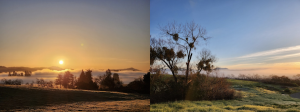
Writing and photos by June Friesen.
Scripture is from The Message translation.
Join Christine Sine January 27th, 2023 10 am – 12 pm PT for a virtual retreat, Spiritual Discernment: Finding Direction in a Confusing World, as she facilitates an exploration of practices that enable us to become “all ears” and listen in all circumstances to the voice of God. This session will be full of helpful input, discussion and creativity. Come join us and learn to listen more deeply to the voice of God.
by Lilly Lewin
Happy Birthday Christine Sine! Thanks for all you do for Godspacelight! and for all the love and wonder you bring to God’s Kingdom and to all of us! In honor of Christine’s birthday today, and my own birthday tomorrow, I am reposting my BIRTHDAY EXAMEN! In true hobbit fashion, I am planning to take the next few weeks to consider all the gifts I want to share with the world in 2024! Please take time to send Birthday love to Christine since she makes all this possible! I am so grateful to be a Liturgical Rebel with you!
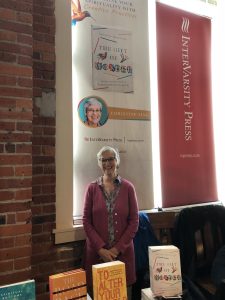
christine
BIRTHDAY EXAMEN inspired by Father Michael Sparough
Birthdays give us an opportunity to look back and look forward
To celebrate who we are and where we’ve been.
To take a look at what makes you, YOU and take time to celebrate that!
What do you like about yourself?
What are you grateful for today?
What would you like to heal?
What would you like to learn more about?
How can you celebrate who you are today even if your birthday to months away?
Like do a Birthday Examen Practice today on yourself…
First feel God’s amazing love surrounding you!
Second…what are you grateful for in your life…? As Father Michael Sparough says…not a list of things but rather a savoring of the gifts in your life….you talents, the people God has brought to you and are in your life now. Your faith and the journey you’ve been on with Jesus.
Opportunities you’ve had ….gifts of the spirit in your life…generosity, patience, kindness etc
Take some time to truly be grateful today.
What about feelings…how have you felt about your life…maybe you’ve been disappointed, hurt, suffered had heart breaks, set backs …talk to Jesus about these…the God of love is loving you, smiling at you, holding you ! NOT JUDGING YOU.
LISTEN to what Jesus says to you! Allow Him to love you even in the hard memories. Give Jesus the negatives to hold and carry for you.
Finally, LOOK FORWARD in HOPE! What are the good things, the things you want to take into this year ahead? In our Epiphany retreat, Christine helped us consider the intentions, rather than resolutions, we want in the new year.
Sit for a while and imagine Jesus smiling at you and listening to you as a dear friend would over coffee or tea. Listen to Jesus. Sit with Him in His LOVE.
As you look ahead, ask Jesus for the GRACE you need for the new year. Feel His loving arms surrounding you!
Take time to connect with those friends who remind you of who you really are! Give them a call, go out for coffee or have a zoom chat with a whole group of friends and celebrate the wonder of each of you!
Walk with Jesus into this new month and into this new year! Take time to celebrate who God has designed you to be!
There is only ONE YOU! Blessings!
As an Amazon Associate, I receive a small amount for purchases made through appropriate links.
Thank you for supporting Godspace in this way.
When referencing or quoting Godspace Light, please be sure to include the Author (Christine Sine unless otherwise noted), the Title of the article or resource, the Source link where appropriate, and ©Godspacelight.com. Thank you!

